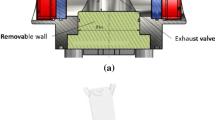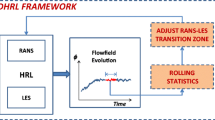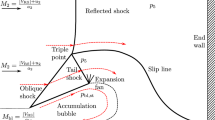Abstract
We study ignition processes in the turbulent reactive flow established downstream of highly under-expanded coflowing jets. The corresponding configuration is typical of a rocket engine igniter, and to the best knowledge of the authors, this study is the first that documents highly resolved numerical simulations of such a reactive flowfield. Considering the discharge of axisymmetric coaxial under-expanded jets, various morphologies are expected, depending on the value of the nozzle pressure ratio, a key parameter used to classify them. The present computations are conducted with a value of this ratio set to fifteen. The simulations are performed with the massively parallel CREAMS solver on a grid featuring approximately 440,000,000 computational nodes. In the main zone of interest, the level of spatial resolution is D/74, with D the central inlet stream diameter. The computational results reveal the complex topology of the compressible flowfield. The obtained results also bring new and useful insights into the development of ignition processes. In particular, ignition is found to take place rather far downstream of the shock barrel, a conclusion that contrasts with early computational studies conducted within the unsteady RANS computational framework. Consideration of detailed chemistry confirms the essential role of hydroperoxyl radicals, while the analysis of the Takeno index reveals the predominance of a non-premixed combustion mode.






















Similar content being viewed by others
Abbreviations
- A :
-
Pre-exponential factor
- \(c_{p}\) :
-
Heat capacity at constant pressure
- \(c_{v}\) :
-
Heat capacity at constant volume
- D :
-
Diameter of the central inlet stream
- \(D_\mathrm {DM}\) :
-
Mach disk diameter
- \(E_\mathrm {A}\) :
-
Activation energy
- \(G_\mathrm {FO}\) :
-
Takeno index
- k :
-
Turbulent kinetic energy
- \(L_i\) :
-
Computational domain length (direction i)
- \(L_\mathrm {s}\) :
-
Length of the subsonic pocket
- M :
-
Mach number
- \({\varvec{n}}_\mathbf{F}\) :
-
Normal unit vector to fuel isolines
- \({\varvec{n}}_\mathbf{O}\) :
-
Normal unit vector to oxidizer isolines
- \(N_i\) :
-
Number of grid points in direction i
- P :
-
Pressure
- r :
-
Radial coordinate \(r=\sqrt{x_2+x_3}\)
- \(r_\mathrm {st}\) :
-
Stoichiometric mass fraction
- R :
-
Universal gas constant
- T :
-
Temperature
- u :
-
Velocity
- \(u_\mathrm {c}\) :
-
Central jet bulk flow velocity
- \((x_1,x_2,x_3)\) :
-
Cartesian coordinates
- \((x_1,r,\varTheta )\) :
-
Cylindrical coordinates
- \(x_\mathrm {DM}\) :
-
Mach disk abscissa
- \(Y_j\) :
-
Mass fraction of species j
- \(Z_j\) :
-
Mass fraction of chemical element j
- \(\alpha \) :
-
Normalized production rate of \(\mathrm {HO_2}\)
- \(\varDelta x_i\) :
-
Spatial resolution in direction i
- \(\varepsilon \) :
-
Turbulent dissipation rate
- \(\lambda \) :
-
Reactivity
- \(\xi _k\) :
-
Tracer of the k-th inlet
- \(\xi \) :
-
Mixture fraction
- \(\xi _\mathrm {st}\) :
-
Mixture fraction at stoichiometry
- \(\phi \) :
-
Equivalence ratio
- \(\zeta _\mathrm {p}\) :
-
Premixedness index
- \(\omega _0\) :
-
Heat release rate (HRR)
References
Hurlbert, E.A., Moreland, R.J., Candel, S.M.: Propellant ignition and flame propagation, In: Yang, V., Habiballah, M., Hulka, J., Popp, M. (eds.) Liquid Rocket Thrust Chambers, Progress in Astronautics and Aeronautics, vol. 200, pp. 405–435. AIAA Inc. (2004)
Saturn V news references, J-2 engine fact sheet (1968). http://www.nasa.gov/centers/marshall/pdf/499245main_J2_Engine_fs.pdf (2016). Accessed 20 Dec 2016
Börner, M., Manfletti, C.: Laser ignition of a multi-injector liquid rocket engine. Space Propulsion Conference 2014, Cologne (Germany), 19th–22nd May 2014
Soller, S., Boronine, E., Kniesner, B., Wiedmann, D.: Thrust chamber technology investigation for expander-cycle engines. Space Propulsion Conference 2014, Cologne (Germany), 19th–22nd May 2014
Armstrong, E.: Ignition systems for liquid oxygen (LOX)/hydrocarbon booster engines. NASA Report TM102033 (1989)
Frenken, G., Vermeulen, E., Bouquet, F., Sanders, B.: Development status of the ignition system for Vinci. AIAA Paper 2002-4330 (2002)
Izard, J.F., Mura, A.: Stabilization of non-premixed flames in supersonic reactive flows, Comptes Rendus Mecanique. In: Candel, S., Richecoeur, F. (eds.) Special Issue: Combustion for Aerospace Propulsion, vol. 337(6–7), pp. 362–372 (2009)
Franquet, E., Perrier, V., Gibout, S., Bruel, P.: Free underexpanded jets in a quiescent medium: A review. Prog. Aerosp. Sci. 77, 25–53 (2015)
Ashkenas, H., Sherman, F.S.: Structure and utilization of supersonic free jets in low density wind tunnels. In Proc. 4th Int. Symp. Rarefied Gas Dyn. 2, 84–105 (1966)
Buttay, R., Lehnasch, G., Mura, A.: Analysis of small-scale scalar mixing processes in highly under-expanded jets. Shock Waves 26, 193–212 (2016)
Crist, S., Sherman, P.M., Glass, D.R.: Study of the highly under-expanded sonic jet. AIAA J. 4, 68–71 (1966)
Buttay, R.: Etude de l’interaction choc / turbulence / combustion en écoulements cisaillés réactifs: analyse des jets réactifs fortement sous-détendus, PhD Thesis, University of Poitiers (2015)
Chigier, N.A., Beer, J.M.: The flow region near the nozzle in double concentric jets. ASME J. Basic Eng. 4, 797–804 (1964)
Williams, T.J., Ali, M.R.M.H., Anderson, J.S.: Noise and flow characteristics of coaxial jets. J. Mech. Eng. Sci. 11, 133–138 (1969)
Favre-Marinet, M., Camano-Schettini, E.B., Sarboch, J.: Near-field of coaxial jets with large density difference. Exp. Fluids 26, 97–106 (1999)
Rehab, H., Villermaux, E., Hopfinger, E.J.: Flow regimes of large-velocity-ratio coaxial jets. J. Fluid Mech. 345, 357–381 (1997)
Rehab, H., Villermaux, E., Hopfinger, E.J.: Geometrical effects on the near-field flow structure of coaxial jets. AIAA J. 36, 867–869 (1998)
Balsara, D.S., Shu, C.W.: Monotonicity preserving weighted essentially non-oscillatory schemes with increasingly high-order of accuracy. J. Comput. Phys. 106, 405–452 (2000)
Ferrer, P.J.M., Buttay, R., Lehnasch, G., Mura, A.: A detailed verification procedure for compressible reactive multicomponent Navier–Stokes solver. Comput. Fluids 89, 88–110 (2014)
Brown, P.N., Byrne, G.D., Hindmarsh, A.C.: VODE: A variable-coefficient ODE solver. SIAM J. Sci. Stat. Comput. 10, 1038–1051 (1989)
Ern, A., Giovangigli, V.: Multicomponent Transport Algorithms, Lecture Notes in Physics, New Series Monographs, m 24. Springer, Heidelberg (1994)
Ern, A., Giovangigli, V.: Fast and accurate multicomponent transport property evaluation. J. Comput. Phys. 120, 105–116 (1995)
O’Conaire, M., Curran, H.J., Simmie, J.M., Pitz, W.J., Westbrook, C.K.: A comprehensive modeling study of hydrogen oxidation. Int. J. Chem. Kinet. 36, 603–622 (2004)
Mueller, M.A., Yetter, R.A., Dryer, F.L.: Flow reactor studies and kinetic modeling of the H2/O2 reaction. Int. J. Chem. Kinet. 31, 113–125 (1999)
Takayama, K., Ben-Dor, G.: The inverse Mach reflection. AIAA J. 23, 1853–1859 (1985)
Hagemann, G., Frey, M.: Shock pattern in the plume of rocket nozzles: needs for design consideration. Shock Waves 17, 387–395 (2008)
Deck, S.: Delayed detached eddy simulation of the end-effect regime and side-loads in an overexpanded nozzle flow. Shock Waves 19, 239–249 (2009)
Shams, A., Lehnasch, G., Comte, P., Deniau, H., de Roquefort, T.A.: Unsteadiness in shock-induced separated flow with subsequent reattachment of supersonic annular jet. Comput. Fluids 78, 63–74 (2013)
Bilger, R.W.: Turbulent jet diffusion flames. Prog. Energy Combust. Sci. 1, 87–109 (1976)
Bray, K.N.C., Peters, N.: Laminar flamelets in turbulent flames. In: Libby, P.A., Williams, F.A. (eds.) Turbulent Reacting Flows. Academic Press, Cambridge (1994)
Gomet, L., Robin, V., Mura, A.: A multiple-inlet mixture fraction model for nonpremixed combustion. Combust. Flame 162, 668–687 (2015)
Ewan, B.C.R., Moodie, K.: Structure and velocity measurements in under-expanded jets. Combust. Sci. Technol. 45, 275–288 (1986)
Chauveau, C., Davidenko, D.M., Sarh, B., Gokalp, I., Avrashkov, V., Fabre, C.: PIV measurements in an under-expanded hot free jet. In: 13th International Symposium on Application of Laser Techniques to Fluid Mechanics, Lisbon, Portugal, 26–29 June (2006)
Dubois, J., Amielh, M., Anselmet, F., Gentilhomme, O.: Investigation of axisymmetric under-expanded air and helium jets by background oriented schlieren. J. Vis. 12(3), 192 (2009)
Celik, I.B., Cehreli, Z.N., Yavuz, I.: Index of resolution quality for large eddy simulations. J. Fluids Eng. 127, 949–958 (2005)
Moule, Y., Sabelnikov, V.A., Mura, A.: Highly resolved numerical simulation of combustion in supersonic hydrogen-air coflowing jets. Combust. Flame 161, 2647–2668 (2014)
Métais, O., Lesieur, M.: Spectral large-eddy simulation of isotropic and stably stratified turbulence. J. Fluid Mech. 239, 157–194 (1992)
Piomelli, H.: Large-eddy simulation: achievements and challenges. Prog. Aerosp. Sci. 35, 335–362 (1999)
Boivin, P., Jimenez, C., Sanchez, A.L., Williams, F.A.: An explicit reduced mechanism for H2-air combustion. Proc. Combust. Inst. 33, 517–523 (2011)
Mastorakos, E.: Ignition of turbulent non-premixed flames. Prog. Energy Combust. Sci. 35, 57–97 (2009)
Boivin, P., Dauptain, A., Jimenez, C., Cuenot, B.: Simulation of a supersonic hydrogen-air autoignition-stabilized flame using reduced chemistry. Combust. Flame 159, 1779–1790 (2012)
Vincent-Randonnier, A., Moule, Y., Ferrier, M.: Combustion of Hydrogen in Hot Air Flows Within LAPCAT-II Dual Mode Ramjet Combustor at ONERA-LAERTE Facility: Experimental and Numerical Investigation, AIAA Paper 2014-2932 (2014)
Techer, A., Lehnasch, G., Mura, A., Moule, Y.: Large Eddy Simulations of Combustion in a Supersonic Mach 2 Transverse Flow, AIAA Paper 2015-3543 (2015)
Ingenito, A., Cecere, D., Giacomazzi, E.: Large eddy simulation of turbulent hydrogen-fuelled supersonic combustion in an air cross-flow. Shock Waves 23, 481–494 (2013)
Fureby, C., Fedina, E., Tegner, J.: A computational study of supersonic combustion behind a wedge-shaped flameholder. Shock Waves 24, 41–50 (2014)
Acknowledgements
The present work is part of the Ph.D. Thesis of Romain Buttay, financially supported by CNRS and Région Poitou-Charentes. This work was granted access to the HPC resources of IDRIS under the allocations x20142a0912 and x20142b7251 made by GENCI (Grand Equipement National de Calcul Intensif).
Author information
Authors and Affiliations
Corresponding author
Additional information
Communicated by K. Hannemann and A. Higgins.
Appendices
Appendix 1: Governing equations and multicomponent transport representation in CREAMS solver
CREAMS solves the three-dimensional Navier–Stokes equations written for a multicomponent mixture
where \(\varvec{q}=\big ({\rho },{\rho } {u}_1,{\rho } {u}_2,{\rho } {u}_3,{\rho } e_\mathrm {t},{\rho } Y_1,\ldots ,{\rho } Y_{\alpha },\ldots ,{\rho } Y_{\mathcal {N}_\mathrm {sp}} \big )^T\) denotes the vector of conserved quantities, while the inviscid (Euler) and viscous flux vector components are given by
and
respectively. The vector \(\varvec{s}\) corresponds to chemical source terms: \(\varvec{s}= \left( 0,0,0,0,0,\rho \dot{\omega }_1,\ldots ,\rho \dot{\omega }_{\mathcal {N}_\mathrm {sp}} \right) ^T\).
In the above equations \(\rho \) denotes the density, \(\varvec{u}\) is the velocity vector, P is the pressure, \(e_\mathrm {t}\) is the total energy per unit mass (defined below), \(Y_\alpha =\rho _\alpha /\rho \) is the mass fraction of the \(\alpha \)th species (\(\alpha = 1,\ldots ,{\mathcal {N}_\mathrm {sp}}\)), with \({\mathcal {N}_\mathrm {sp}}\) the total number of chemical species, and \(\dot{\omega }_\alpha \) its production rate. \(\tau _{ij}\) is the Newtonian shear stress tensor. \(\mathcal {J}_j\) and \(V_{\alpha ,j}\) are the j-components of the heat flux and the species diffusion velocity, respectively.
The above system of conservation equations is complemented by the ideal-gas equation of state written for a multicomponent system \({P}={{\rho }{\mathcal {R}}{T}}/{\mathcal {W}}\), where \(\mathcal {R}\) is the universal gas constant and \(\mathcal {W}\) is the molecular mass of the mixture which is obtained as the sum of the molecular mass of the species \(\mathcal {W}^{-1}= \sum _{\alpha =1}^{\mathcal {N}_\mathrm {sp}} Y_{\alpha } / \mathcal {W}_{\alpha }\). The total energy \(e_\mathrm {t}\) is given by \(e_\mathrm {t}={{{u}_i{u}_i}}/{2}+ \sum ^{\mathcal {N}_\mathrm {sp}}_{\alpha =1} {h}_\alpha Y_\alpha - {P}/{\rho }\), where \(h_\alpha \) denotes the enthalpy of the \(\alpha \)th species
The specific heat capacity at constant pressure of each species is standardly expressed as a polynomial form of the temperature T. Since the nonlinear dependency of the specific heat capacities on the temperature prevents the direct calculation of the latter given the total energy, a Newton–Raphson iterative algorithm is used to solve the resulting system.
The transport coefficients in multicomponent mixtures are not given explicitly by the kinetic theory and require solving large linear systems. Here they are evaluated following the approach described by Ern and Giovangigli [21, 22].
The shear stress tensor is given by
where \(\kappa \) and \(\mu \) denote the volume and shear viscosity, respectively.
The heat flux is expressed as follows
where \(\lambda \) is the thermal conductivity of the mixture and \(\tilde{\chi }_{\alpha }\) is the rescaled thermal diffusion ratios of the \(\alpha \)th species, which is defined such that \(\sum _{\beta } X_{\beta } \tilde{\chi }_{\beta }=0\) and \(\sum _{\beta } D_{\alpha \beta } X_{\beta } \tilde{\chi }_{\beta } = \theta _{\alpha }\), with \(\alpha \) and \(\beta \in \left[ 1, ..., \mathcal {N}_\mathrm {sp}\right] \). In the previous expression, \(\theta _{\alpha }\) and \(D_{\alpha \beta }\) denote the thermal diffusion vector and diffusion matrix, respectively, while \(X_{\beta }\) denotes the molar fraction of the \(\beta \)th species.
The mass fluxes are represented by
where \(\tilde{D}_{\alpha \beta }\) are the flux diffusion coefficients formed by the flux diffusion components \(Y_\alpha D_{\alpha \beta }\). All the transport coefficients mentioned above, i.e., \(\kappa \), \(\mu \), \(\lambda \), \(\tilde{D}_{\alpha \beta }\), and \(\tilde{\chi }_{\beta }\), are evaluated using the general purpose Fortran library EGLIB [22], which employs an iterative method to obtain an approximate solution to the linear system of transport coefficients derived from the kinetic theory. The molecular transport coefficients, as issued from the library EGLIB, satisfy mass constraints as well as positivity properties ensuring the positivity of entropy production.
The solver offers the opportunity to represent detailed chemical kinetics through \(\mathcal {N}_\mathrm {r}\) elementary reaction steps involving \(\mathcal {N}_\mathrm {sp}\) chemical species
where \(\mathcal {M}_{\alpha }\) is the chemical symbol for the \(\alpha \)th species, \(\nu _{\alpha ,j}'\) stands for the forward stoichiometric coefficients, while \(\nu _{\alpha ,j}''\) denotes the reverse stoichiometric coefficients. The resulting chemical source terms are given by
where \(k_{\mathrm {f}j}\) and \(k_{\mathrm {r}j}\) denote the forward and reverse rate constants of the jth elementary reaction, respectively, and \(\left[ X_\alpha \right] \) is the molar concentration of the \(\alpha \)th species.
Appendix 2: Three-step reduced chemistry
Under the set of hypotheses presented in reference [39] the hydrogen–air chemistry can be reduced to the following three overall steps:
-
(I)
\(3 \mathrm {H_2} + \mathrm {O_2} \rightleftharpoons 2 \mathrm {H_2O} + 2 \mathrm {H}\)
-
(II)
\(2 \mathrm {H} + \mathrm {M} \rightleftharpoons \mathrm {H_2} + \mathrm {M}\)
-
(III)
\(\mathrm {H_2} + \mathrm {O_2} \rightleftharpoons \mathrm {HO_2} + \mathrm {H}.\)
The above description includes a branching reaction (I), a recombination reaction (II), and an initiation reaction (III). Five reactive species \(\mathrm {H_2}\), \(\mathrm {O_2}\), \(\mathrm {H_2O}\), \(\mathrm {H}\), \(\mathrm {HO_2}\) (plus nitrogen diluent) are considered. Chemical-kinetic steady-state approximations have been retained for \(\mathrm {O}\), \(\mathrm {OH}\), and \(\mathrm {H_2O_2}\). According to Boivin et al. [39] the application of a correction factor \(\varLambda \), see (6), significantly improves the performance of the above reduced chemistry.
Rights and permissions
About this article
Cite this article
Buttay, R., Gomet, L., Lehnasch, G. et al. Highly resolved numerical simulation of combustion downstream of a rocket engine igniter. Shock Waves 27, 655–674 (2017). https://doi.org/10.1007/s00193-017-0715-y
Received:
Revised:
Accepted:
Published:
Issue Date:
DOI: https://doi.org/10.1007/s00193-017-0715-y




